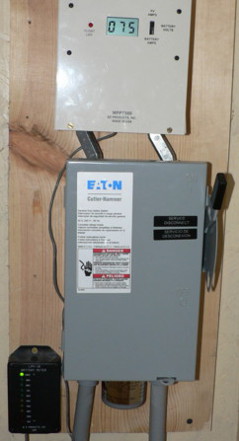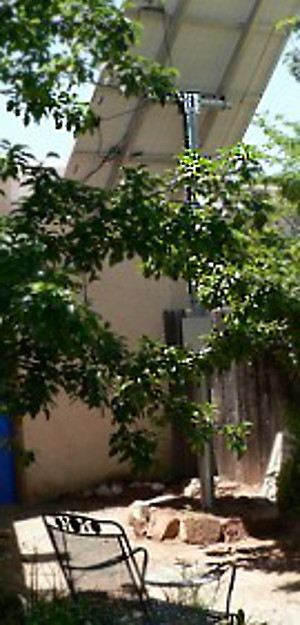
This page shows my solar being installed here in Santa Fe, New Mexico. If you are thinking of getting solar, you can see about what to expect if you choose a pole-top mount, the way I did.
My “Large Cabin System” was a “kit” with batteries. I deliberated between it and ordering each component to my choice, but in the end the kit’s price made it unbeatable.
Only the inverter wasn’t included ~ that’s because the kit came with a direct current electrical box if you want to go that route, like for an actual cabin, instead of AC. Solar panels produce direct current, DC, while the current from the grid is alternating current, AC.
Inverters from some companies sounded good, but weren’t pure sine, so they’d ruin my laser printer over time because the current they produce isn’t as smooth as pure sine. Anyone with sensitive electronic equipment should look for a pure sine inverter. Pure sine is what comes out of a wall socket if you are connected to the grid.

Being absolutely unfamiliar with solar, I considered having the solar panels hung intermittently along my garden fence where I know there is sun all year. But I didn’t want to lose my summer plants; besides, it sounded a bit wonky.
I considered having the panels on my roof, but when the man I’d counted on to remove winter snow from them got sick, I knew there was no way I could go up a ladder and remove snow.

I began to wonder about the rather barren area by the backyard entrance to my garage. I checked it for several mornings running and it was always in full sun, sun up till sun down.
When Robert Althouse, owner of Solarwise USA, came for a look, he saw all the sunshine between my pear tree and garage, checked his compass and said it was a good spot. His estimate was within my budget so after most of my kit arrived, I called him and said I was ready to go ahead. And go ahead we did —
5 foot deep hole
For clay soil it’s recommended to sink a third of the height of the pole into the ground. Digging was quite a task in earth that a few feet down was as hard as stone. Even water didn’t penetrate the long dry clay. But finally the hole was complete and the Sonotube in place so that less concrete could be used with just as sturdy results.
Next Rob with the help of my helper Sa-ul drilled holes in the heavy steel pole so that they could put cross-wise pieces of rebar through to secure the pole in the rebar cage they’d made. The rebar would prevent high winds or years of wind from breaking the pole loose from the grip of the cement and spinning it.
Then, thunder, lightening, torrents of rain, and hail the size of marbles hit.
The fellows were intrepid. They set the heavy steel pole into the Sonotube in the hole, but they still needed the cage inside the Sonotube. Rob said he’d go up the ladder and drop the cage over the top of the pole. The top was so high, it looked impossible to me. (I wish I had a picture, but the rain was so intense I was afraid I’d ruin my camera, besides, I was busy praying.)
Rob was high up the ladder with the rebar cage over his head, about to drop it into place, when a huge flash of lightening and crash of thunder came at the same time. It was as if he was placing the star on a Christmas tree, and it lit up spotlight-bright with a drum roll, almost like a miracle. (I’m glad I had a lightening rod put in on the other side of my house when I thought I’d have the solar panel array on my roof. I don’t know, but maybe that’s where the lightening went. I’m sure glad it didn’t strike Rob, the pole or any of the fellows.)
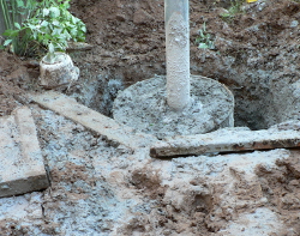
Next they filled the Sonotube with concrete which was also a feat since it was so muddy, and the mud was so slippery. The wheelbarrow, loaded with concrete, kept wanting to slide off the wood planks so that one of the fellows had to push the wheelbarrow while another kept it on track, and then they’d dump it. (While hail was pelting down.) It was major intense.
I so wish I had a picture of the final wheelbarrow full. It had about twice as much concrete as all the other loads, so Cruz couldn’t move it by himself. Sa-ul immediately came to help him and so did Rob, and there they were, the three of them running that wheelbarrow with huge smiles on their faces, as they conquered the elements with their joint force. It was just a beautiful image. That’s the image I most wish I had because it was so beautiful.
Trench to the house

A few days later when things dried out a bit, Rob and Alex came and trenched to the house for the grey conduit pipe that was needed to bring the electricity from the solar panels into the house.
Meanwhile, I was painting the battery box and hoping Sa-ul would be able to complete my solar electrical closet in time. (I need not have worried.)
Battery Box

I wanted the battery box (which would double as a window seat), the electrical closet and my file cabinets to be the same color as Kraftmaid cabinets that are done in Buttercream.
But I’m not awesome at choosing colors so I asked a friend, Glennon, who used to help do the Spiegel catalog if she could tell what Behr paint chip was most like Kraftmaid Buttercream. She could and that’s the color I painted the box, file cabinets and closet.
Less fun was the way HomePower’s battery box article (kindly sent to me by Eric at Gaiam in Hopeland, CA) said to line the battery box with poly-ethylene in case of “catastrophic failure.”
I was flummoxed when Home Depot said they didn’t carry anything like a polyethylene liner. Where would I get one? I was about to give up when I noticed that my Contractor Trash Bags were made by Poly-America.
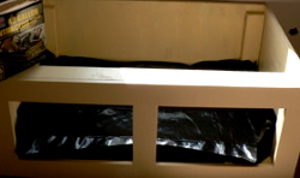
Ah ha, I thought, could my trash bags be made of polyethylene?
I called Poly-America and spoke with Erica, in materials, “What are the trash bags made of?” I asked.
There was a pause, then in a questioning tone Erica replied, “Polyethylene?” as if she wasn’t sure I was serious.
I repeated it after her and she confirmed, “Yes, they are made of polyethylene.” So, I lined my battery box with three Contractor Bags, which is a total of 18 mil.
Pure sine inverter & panels
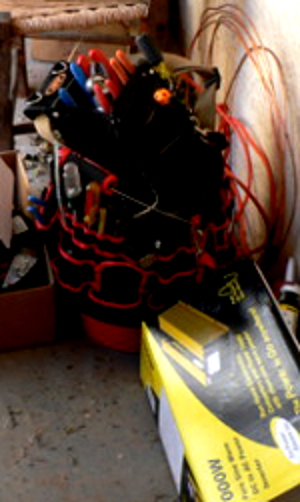
Next, shortly after the arrival of my GoPower 1000 watt, pure sine inverter (so I can happily use my 475 watt HP laser printer)and after Rob had taken a look at my inverter, he brought over his tools and my four Evergreen 120 watt panels (made in Germany) which he had already secured in their poletop mount from Uni-rac.

I was really excited, now. As far as I could tell, it was really happening.
Wiring
But, I wasn’t going to see the array go up quite yet, no matter how much it felt as if I couldn’t wait ~ There were several wiring tasks that needed to be done first.
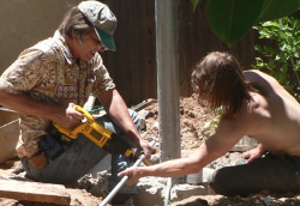
If only I’d done video with sound ~ Rob had a constant patter of positive sayings.
At last ~ Panels in motion
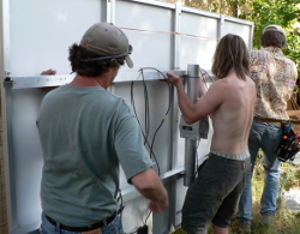
When the conduit was in place, and the trench covered over, then, at last, the panels were in motion.
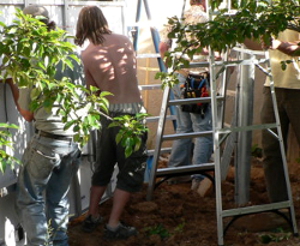
David, Alex, Rob and Brian got ready to “walk” the panels up ladders to the top of the pole. It looked impossible because the pole top was way above their heads.
It took time to get the ladders just where they wanted them…And then they did it. They walked it up and set it in place.
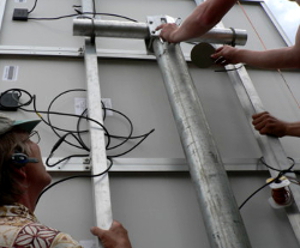
Next they had to lift the array to fix the cap on the pole. (Up until then I’d been wondering if wind going over the open pole would whistle. . . and if it did, I wondered if holes could be drilled in the pole so that the wind would sound like a flute.)
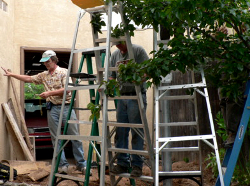
With all the ladders still in place, Rob began taking readings on his compass so that the array could be set to get the most solar all year long, summer and winter. He took readings up close to the pole and others further away in case the pole was affecting the compass needle.
The electrical
Luckily, clever Sa-ul had finished the electrical closet in time (his days are taken up working for Frank Daley, the electrician who put in my lightening rod) by finding a readymade cabinet on sale at Lowe’s.
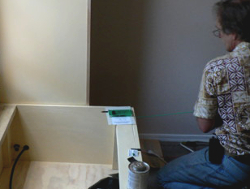
Sa-ul cut the cabinet to fit and had it in place by the time Rob and Alex were ready to draw the wires through the conduit using a steel “fish line.” It was pretty neat.
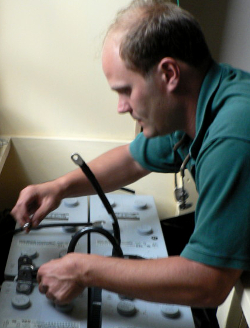
Up until Brian was wiring the batteries I didn’t know that they arrived fully charged. (I’d been worried about how many days charging would take before using my system.)
While he worked Brian gave me talks on direct current and how it’s dangerously different from alternating current, the kind we get from the grid or our inverter.
He drove home how alternating current comes in waves, so if you touch a wire and get a shock you can pull away while there’s a dip in the wave. But with direct current, no waves… so DO NOT drop anything metal where it could touch both the negative and positive.
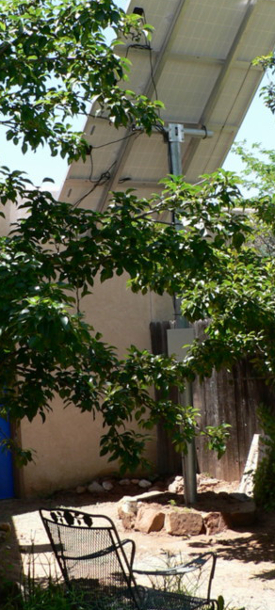
So that’s it.
There’s my solar (pv) array happily above my pear tree and catching solar energy from sun up till sun down. It’s awesome.
You can just barely see the Outback Combiner Box on the pole.
I wanted an Outback Inverter but they cost so much more and I had such a limited budget that I went with GoPower — and it’s working fine. I only wish I’d gotten a 1500 watt one. I have the solar energy to do the wash and vacuum, only I don’t have inverter capability. (Because I really didn’t have any more money.)
I love the stones around the base of the pole. I hope the borage and other flowers thrive. Neat! Neat!!!
My lawn chair in the picture makes me smile. It looks as if I often sit and admire my solar panels on their pole. Really, I sat there to watch the installation and take a lot of the pictures.
Monitoring my panel output
At first I looked inside my electrical closet a lot. I still love to see how many amps I’m getting. You can see that my panels were giving me 6.6 amps when I took this picture. The other day it was raining and I was still getting an amp. When it’s hot outside I get around 6.6 – heat reduces the energy from photo voltaic cells. On cooler days I get more. So, even though during the winter there will be less sun hours I’ll get more amps per hour.
Under the grey box you can see my lightning protector. I bought it extra because we have a lot of lightning here, close to my house.
The wood board is there because I couldn’t afford a pre-assembled set up. Rob put things on the board in his shop then brought it over and attached it inside my solar electric cabinet. Pretty neat!
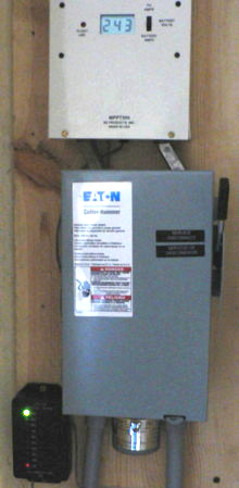 There are other ways of looking at the energy my solar panels are producing. I just happen to prefer the amps. I forget what the larger numbers are.
There are other ways of looking at the energy my solar panels are producing. I just happen to prefer the amps. I forget what the larger numbers are.
The green light on the black box tells me I have 100% of my solar power left. I totally love that! It has always said that, though, because I have to use 10% of what’s stored in my batteries before it drops a level. I bought this battery monitor extra because if you use toomuch energy from your batteries it reduces their life. But “too much” is more than 25%, showing as 80% on the meter, so I’m way safe.
That’s one thing that’s really cool about the Full Time Cabin Kit I got: it came with four 183 amp hour gel batteries, which are big-capacity, no maintenance batteries with little fuming. I don’t have to add water, and there’s no smell from them.
If I’d been able to afford a larger inverter I could run lots of things.But with my brain damage, maybe it’s best I go slow and learn. : ) (I don’t want to give the wrong idea, when you get solar you can’t leave your telly on all the time, or run a regular fridge or electric stove or electric heaters.)
Eric in the California Real Goods store was great because he helped me understand I could run the Frigidaire washing machine I wanted if I did it while the sun was shining and then let the batteries build up their stores again afterwards. The same with vacuuming and using an electric kettle. But see, I didn’t get a big enough inverter. That’s why I have a surplus of electric power. In fact, on sunny days the charge controller has to protect the batteries from over charging. The charge controller came with the kit.
Except for my 15 watt grow light for my seedlings – which I need so I don’t fall at night – I don’t leave lights on anymore. It saves over a kilowatt a day!

